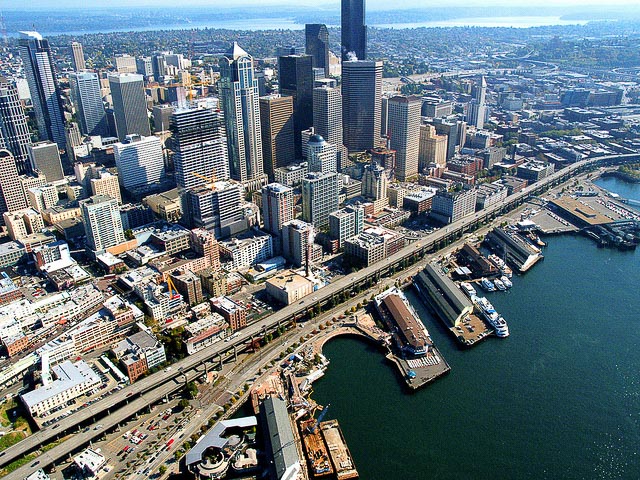Houston is not alone in considering tearing down a part of its downtown highway system.
Seattle is in the midst of tunneling a major roadway and eliminating a boundary between the city and its waterfront.
Dallas has a growing movement to rethink its downtown highway network.
And Toronto recently voted to turn a portion of an elevated downtown highway into a hybrid roadway that will become part surface-level parkway and remain partly elevated.
Why are all these cities looking to take down their highways? And what can Houston learn from the decisions some cities have already made?
A primary impetus for the removal of urban expressways is the simple fact that more and more people are moving back to American downtowns. Those moving into urban areas are often in search of dense, walkable and bikeable communities where bars, restaurants, and cultural centers are close by.
In many city centers, though, infrastructure from the 1950s, 1960s and 1970s create physical obstacles to this way of life. Urban highways disrupt the historic street grid and cut connections between neighborhoods. In many cities, like Seattle, they also block access to desirable amenities like waterfronts.
For city officials looking to attract new residents to downtown, the removal of a highway can offer a huge opportunity to remake the city. Highway teardowns can open up new land for development, tie together formerly disconnected parts of a city or build upon existing amenities in new ways.
The choice to take down a highway also reflects a major change in thinking about the broader transportation system of which it is a part. When the majority of the elevated urban highways now being torn down were built, cities' transportation systems were oriented solely around a larger network of roadways. Downtown roads where built to usher suburbanites into the central business district. Today's multi-nucleated cities, with "downtowns" spread across the metropolitan area, make these older downtown highways increasingly expendable.
Moreover, transportation planning today combines roadways with mass transit. Even in cities like Houston and Dallas, where transit has never had much of a modal share, the reconstruction of highways now includes transit elements like HOT or HOV lanes. The older roadways now being decommissioned often lack the ability to include such elements.
It's easy to get drawn into imagining what could be made in the place of torn down highway. As cities decide the fate of their downtown highways they would be prudent to keep in mind that the process of building or tearing down a highway is both costly and time consuming. In Houston, if the teardown option is selected, the Pierce Elevated won't likely be torn down until well into the 2020s. But there's an opportunity that comes with such a time frame too: it gives residents the chance to push officials to come up with the most effective plan possible.
As cities consider taking down parts of their highway system, they should draw upon lessons from other cities' experiences with the effort. Houstonians should pay attention, in particular, to a few national examples.
- Seattle and Boston: In both cities, highway tunneling was used to open new urban space for development. Boston completed the Big Dig and now has a mass of green space snaking through its core. Seattle intends to take a similar, park-like approach.
- New York and Toronto: The West Side Highway in New York is a great example of the possibilities presented by a teardown. The highway was shifted from an elevated roadway to a surface-level parkway. The move created more space for pedestrians and bicyclists and opened access to the Hudson River waterfront. Likewise, Toronto's highway choice will open parts of the city to its waterline.
- Louisville: When presented with the opportunity to remove a part of I-65 through their downtown, Louisville leaders instead chose to widen the roadway and build an additional bridge. This choice meant that the city's riverfront park and green space would remain disconnected from the city's direct downtown.
As planners embrace the idea that cities should no longer be planned solely for cars, the type of infrastructure we build up or tear down will continue to change.

